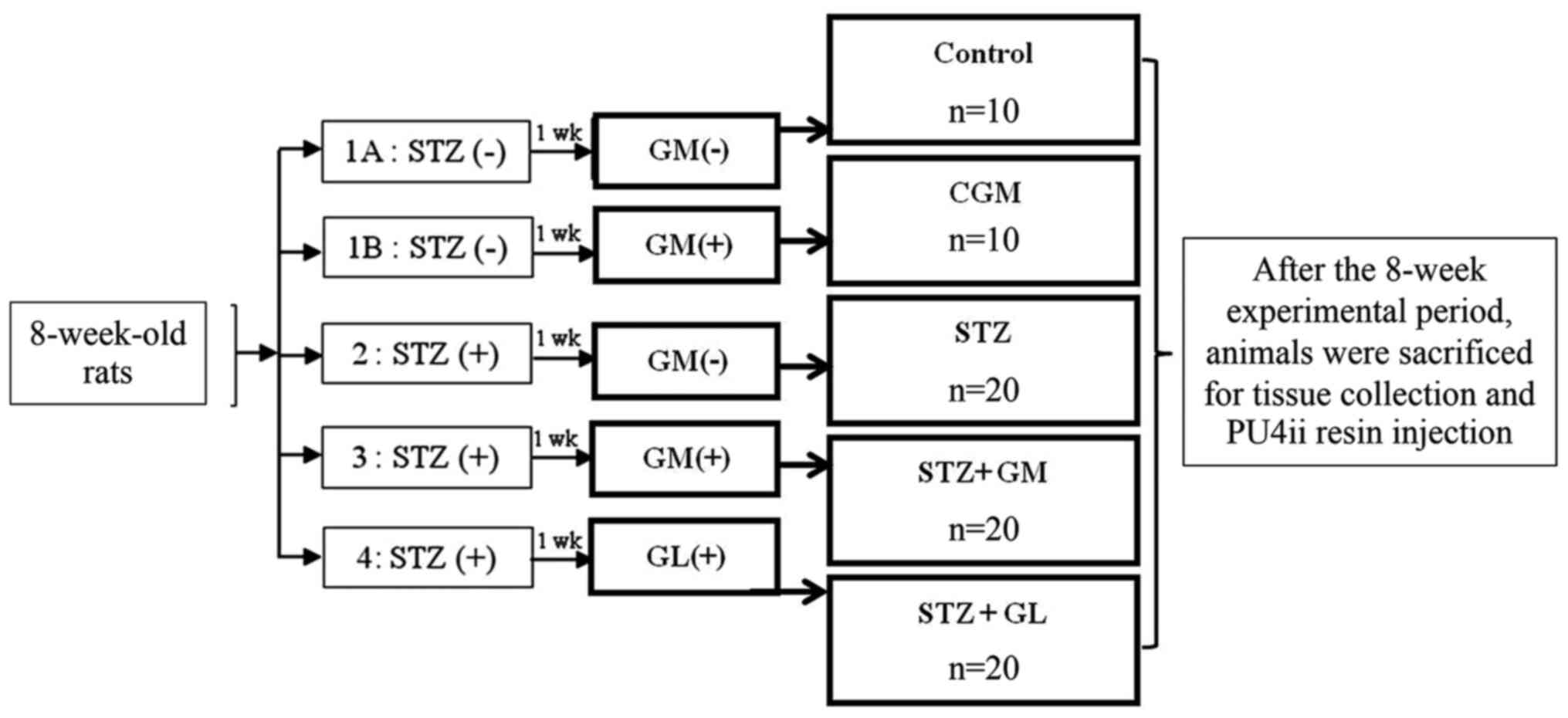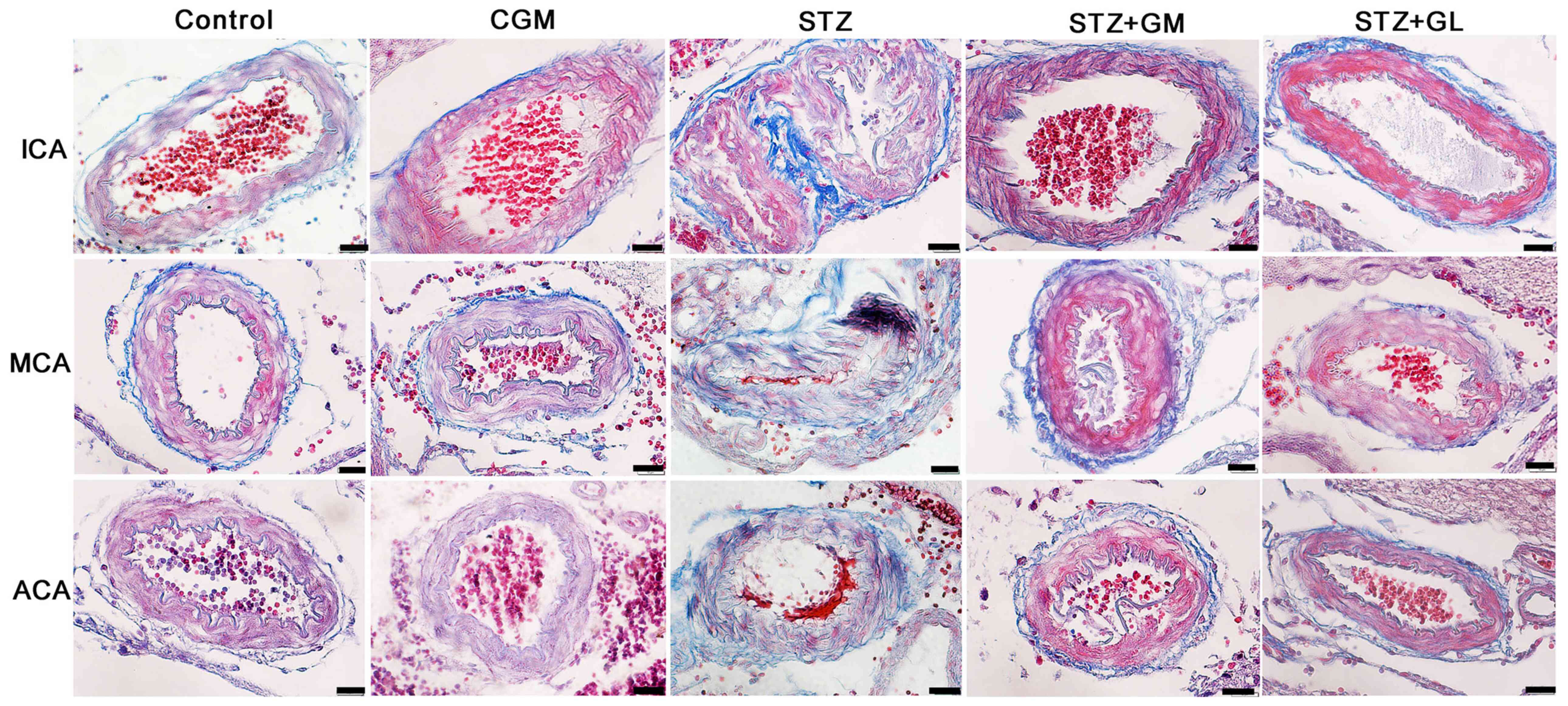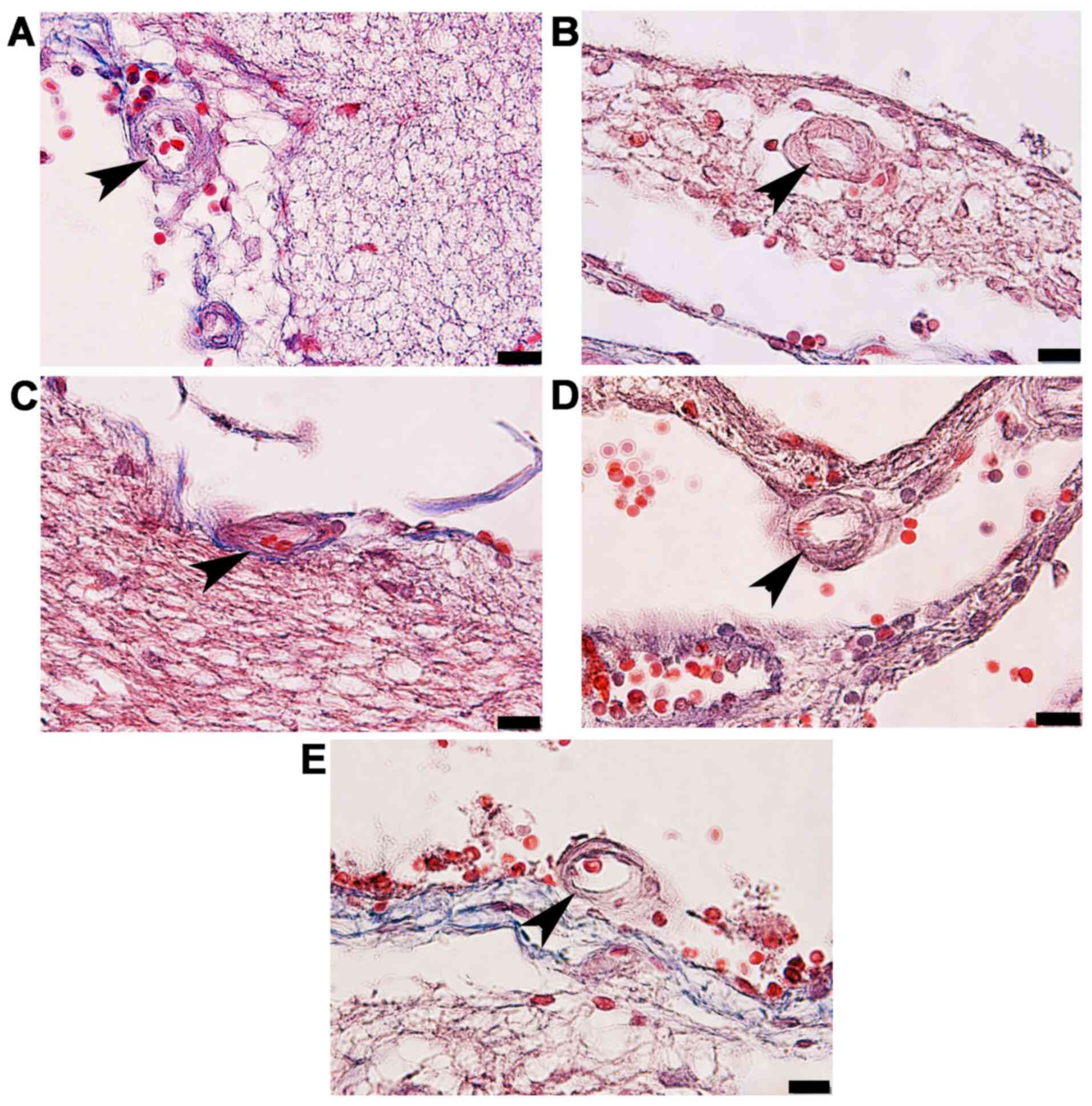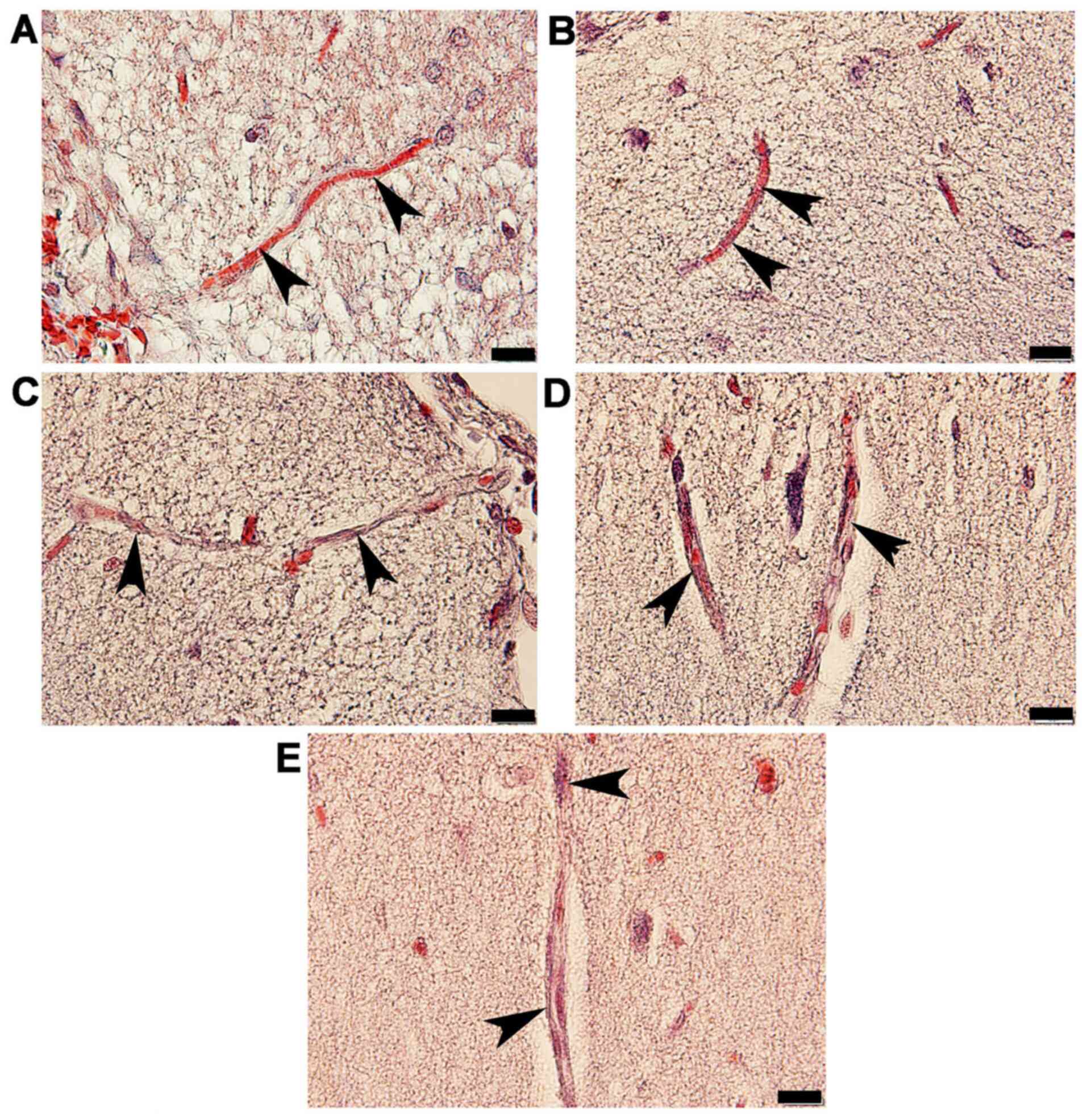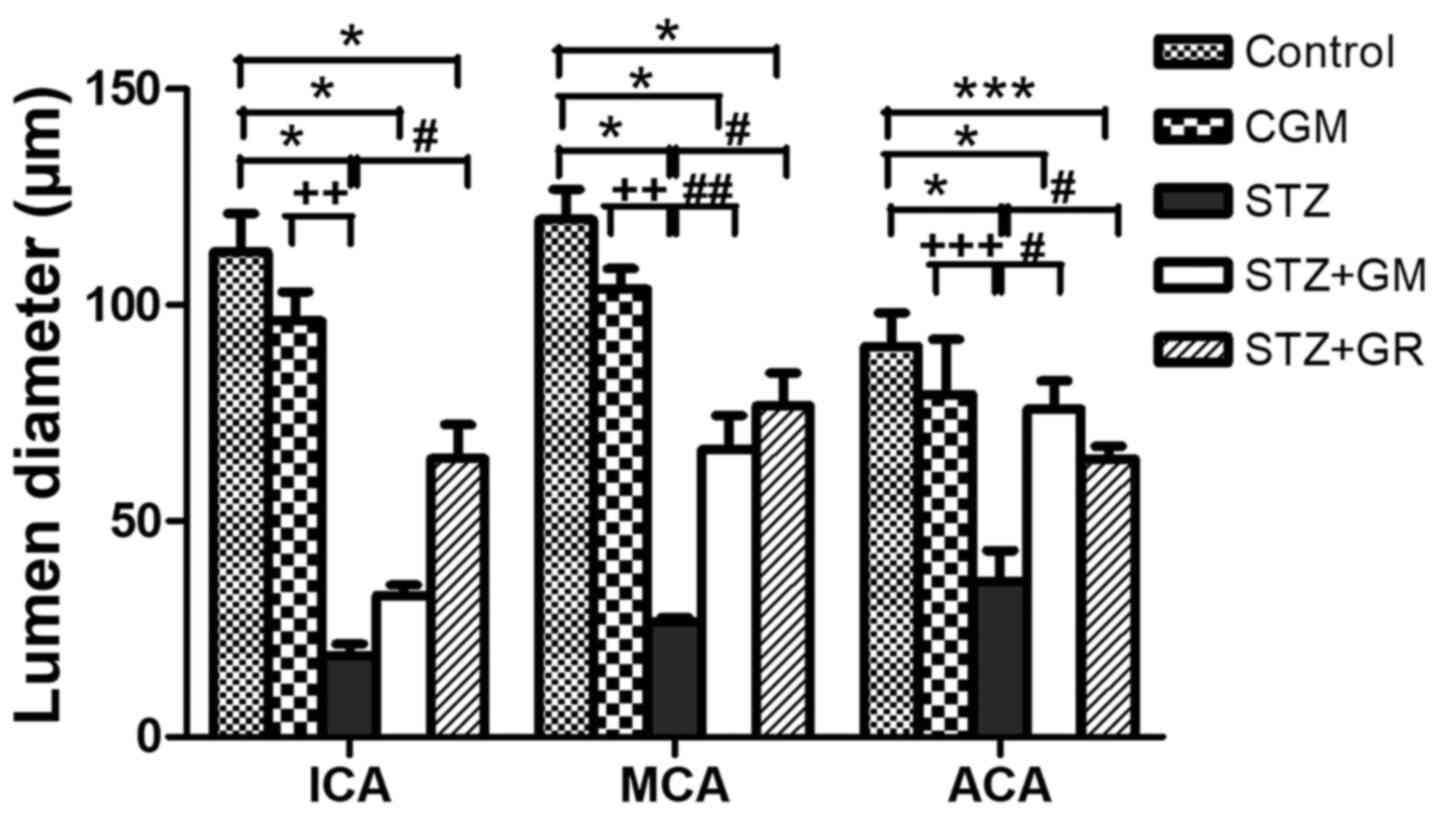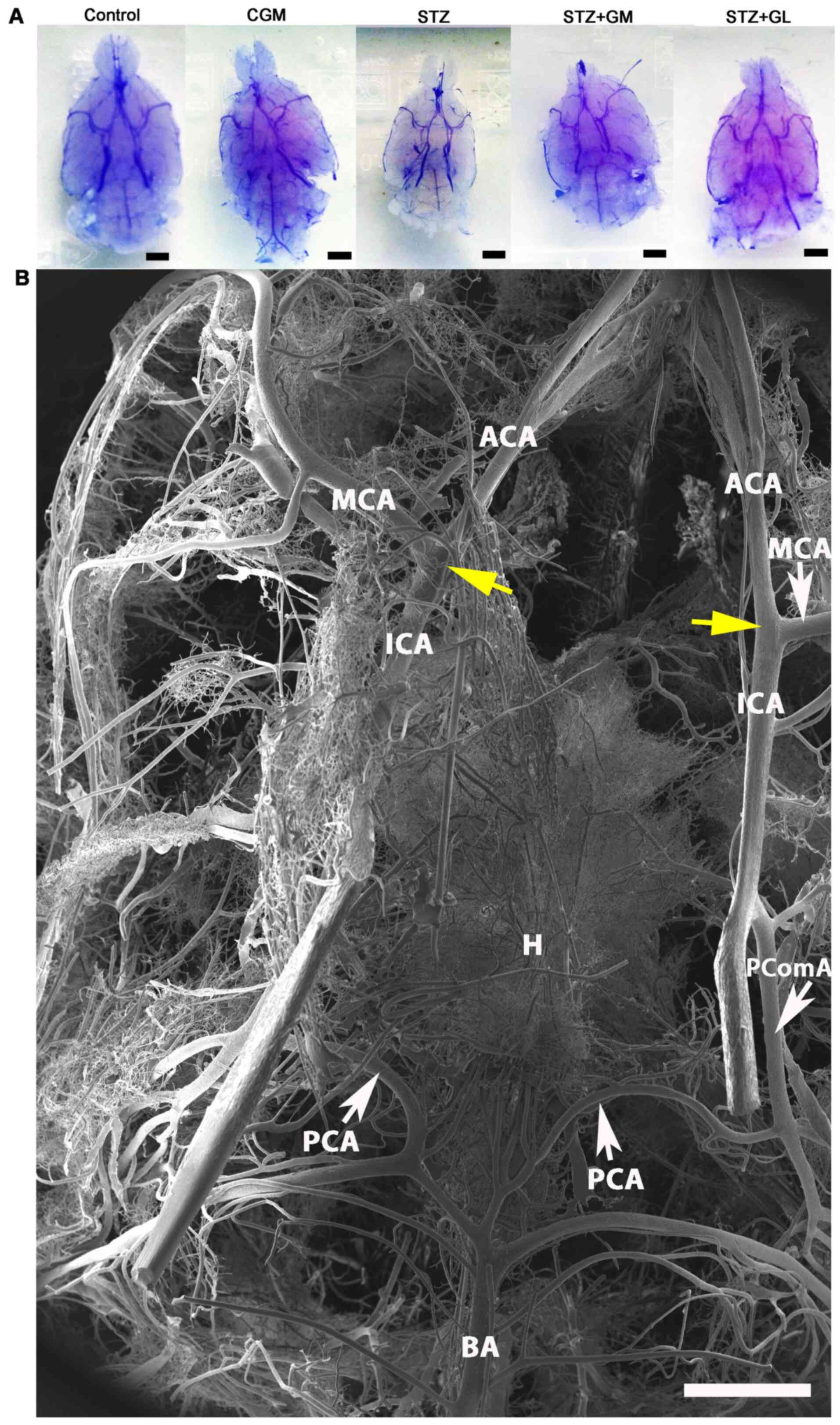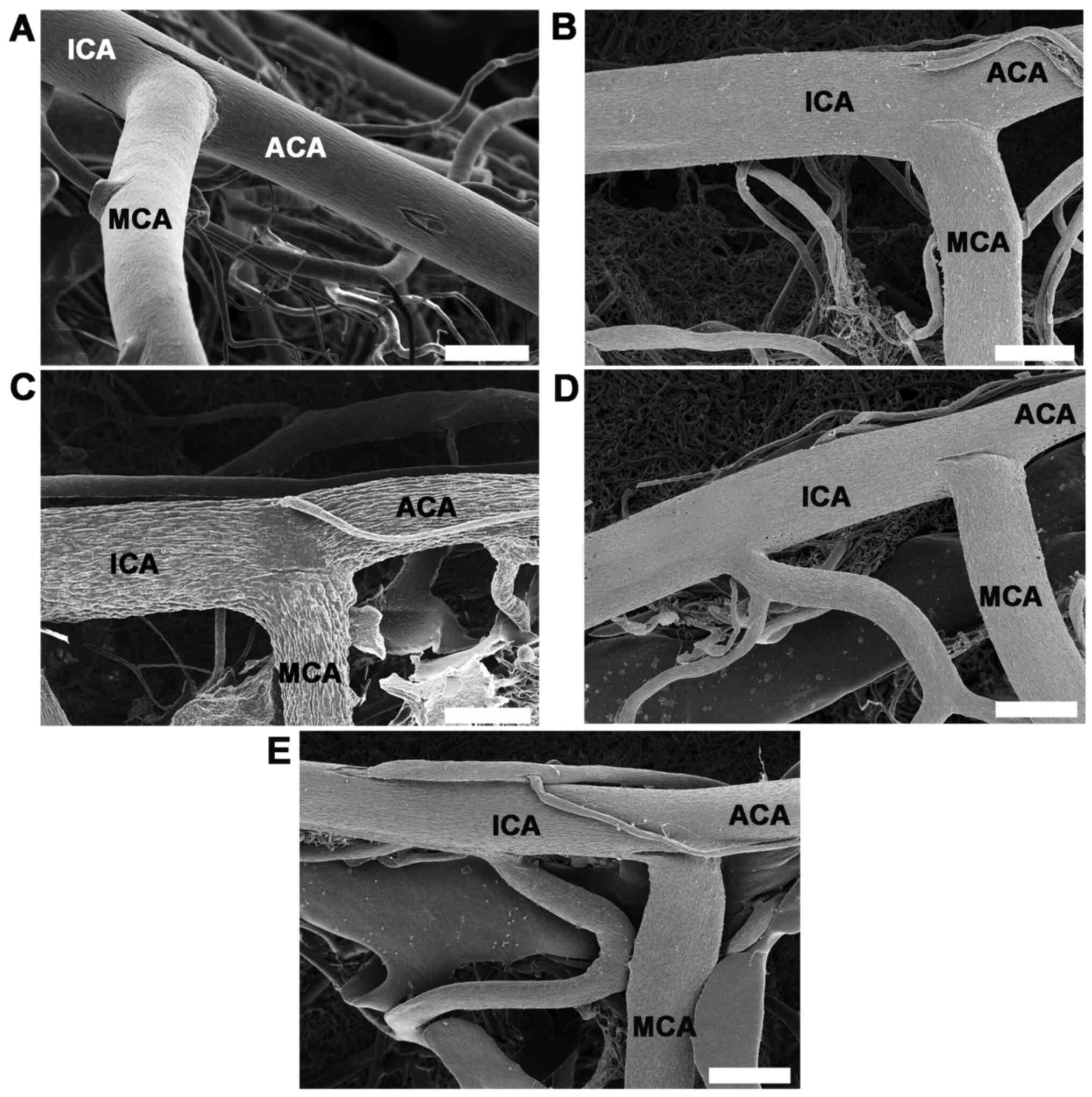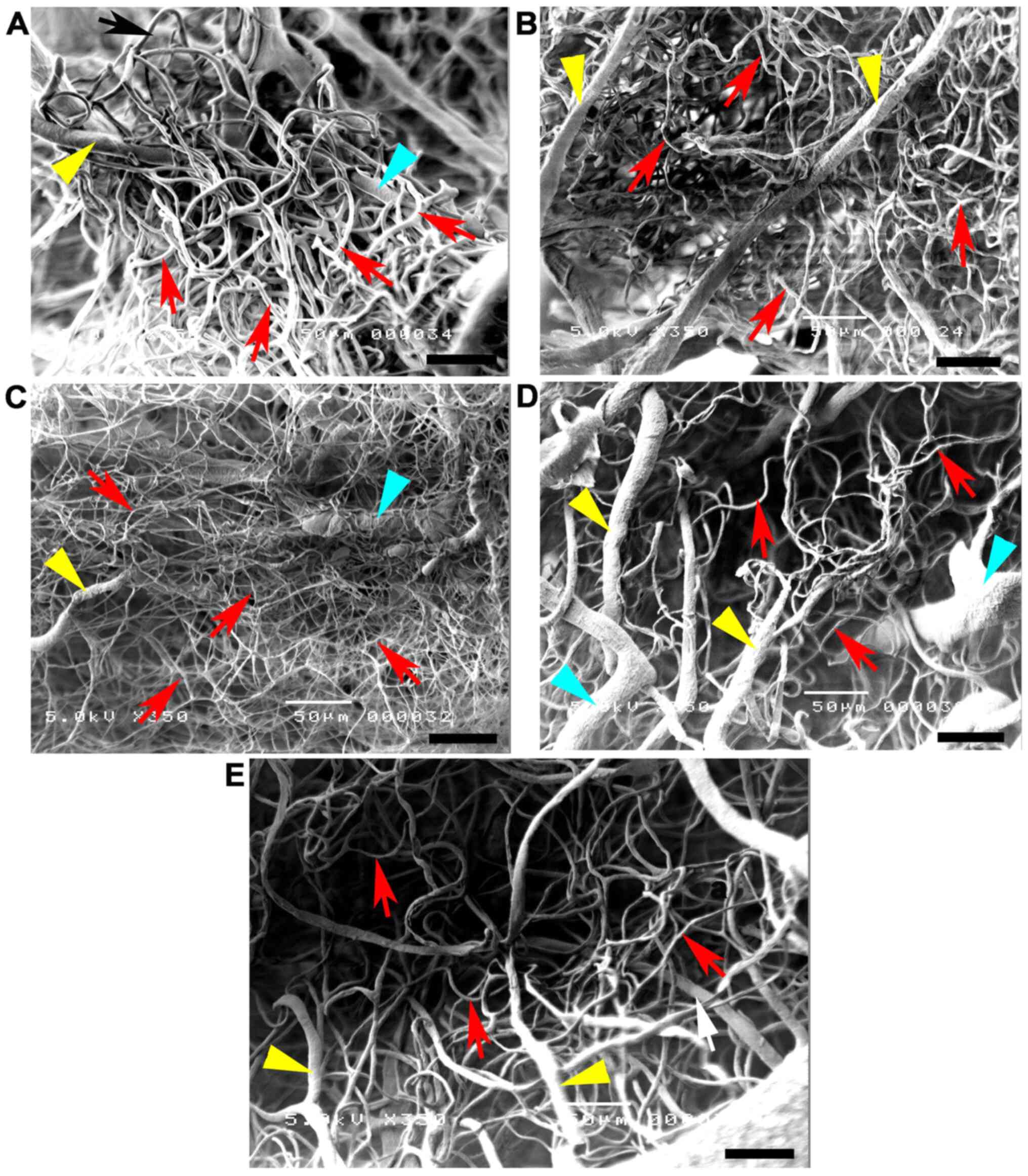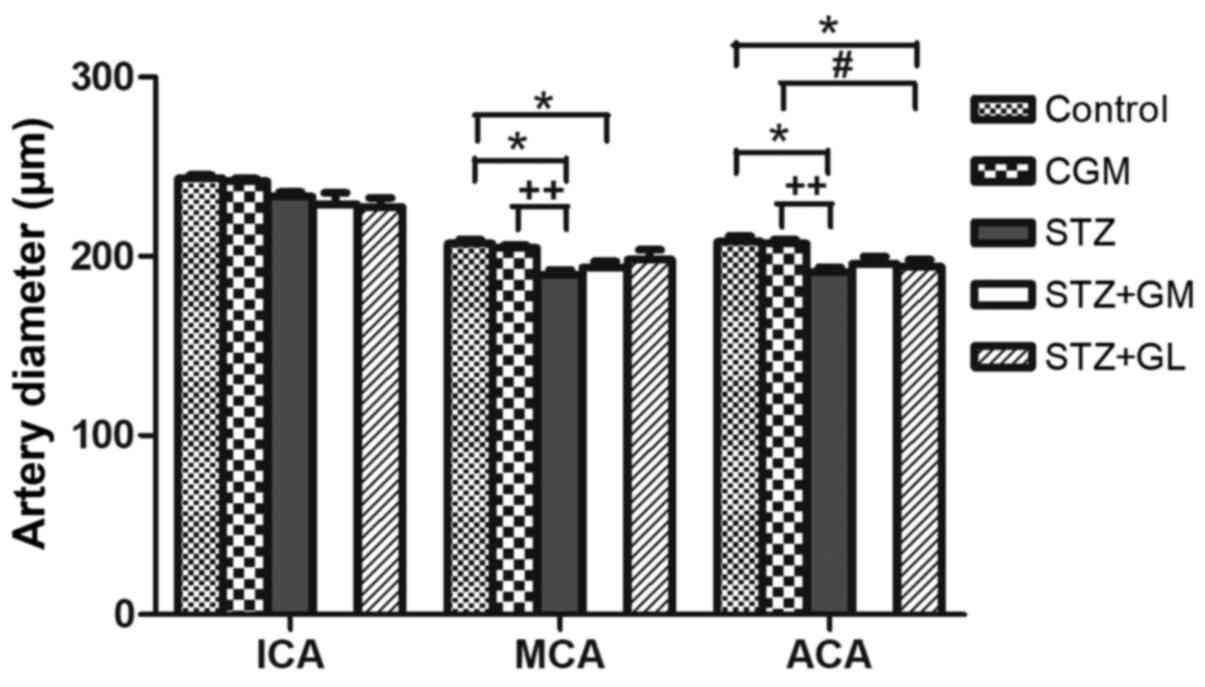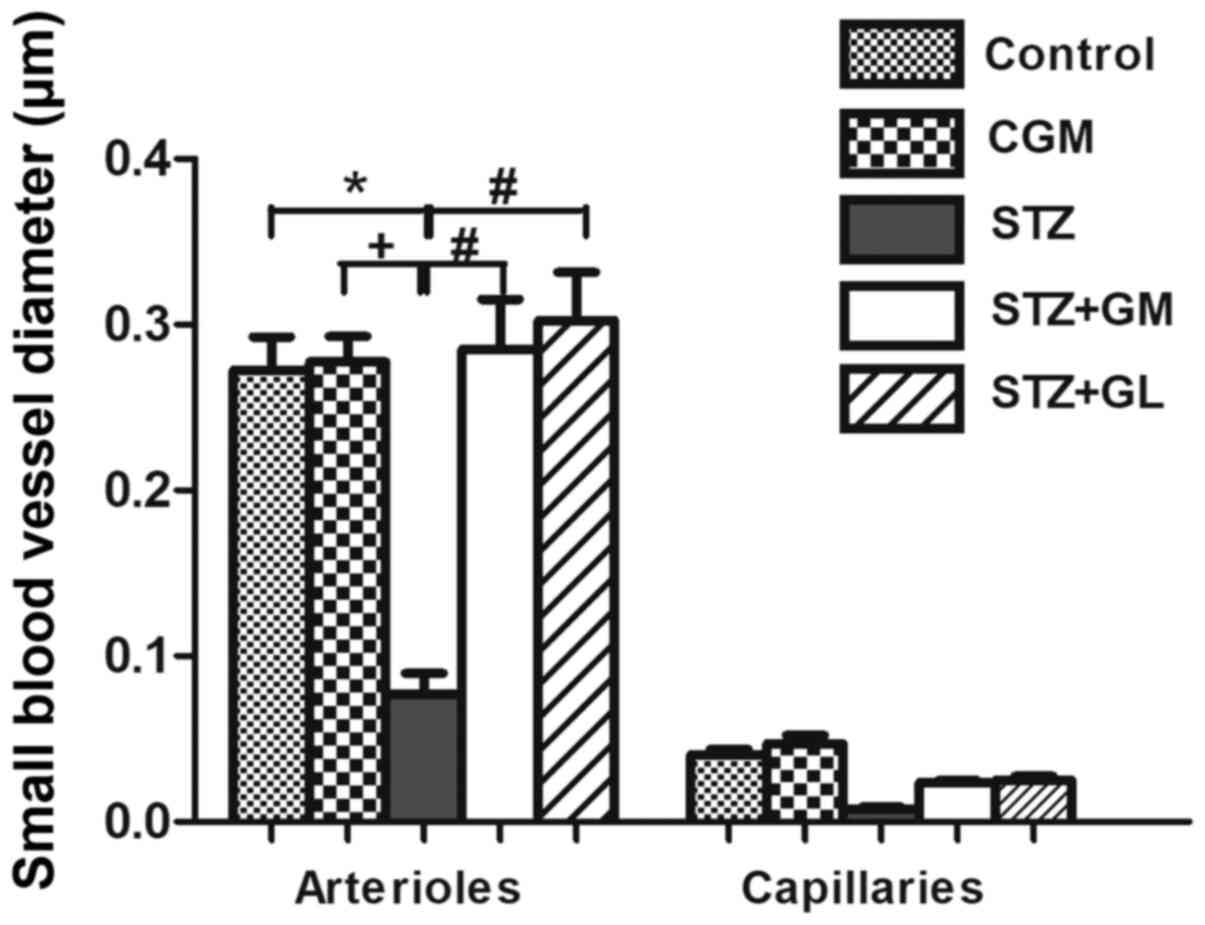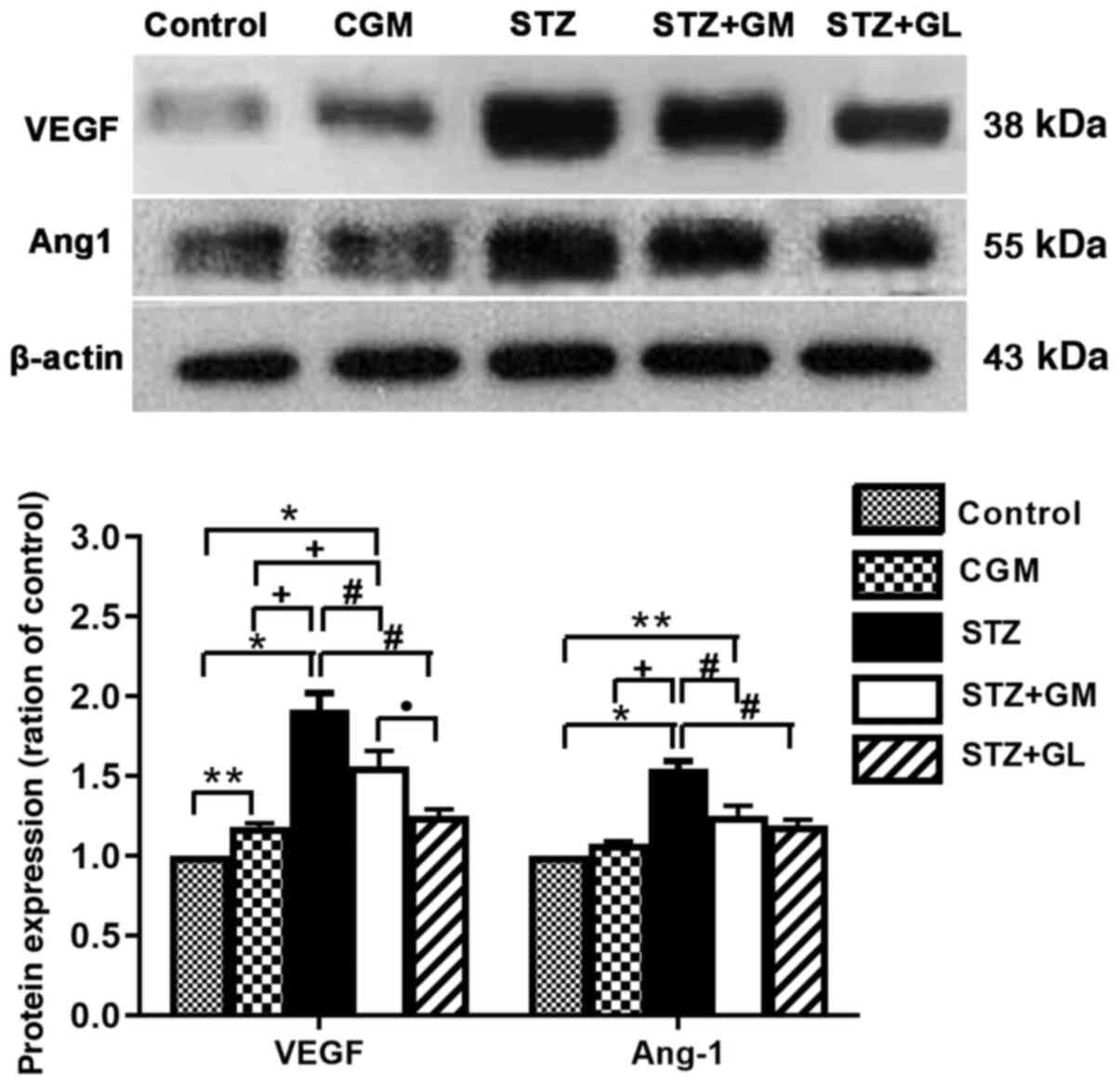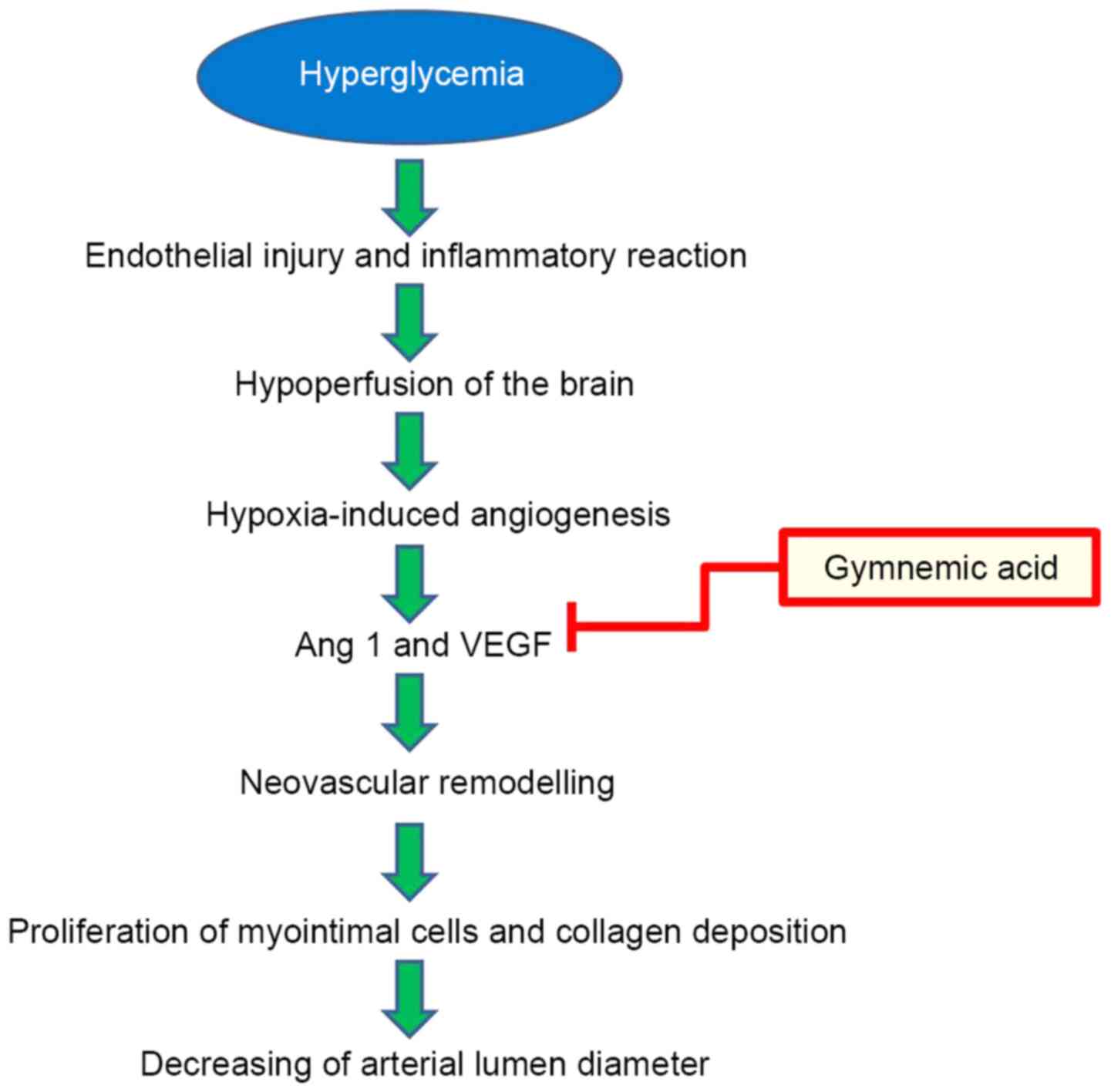|
1
|
American Diabetes Association. Diagnosis
and classification of diabetes mellitus. Diabetes Care. 32 (Suppl
1):S62–S67. 2009.PubMed/NCBI View Article : Google Scholar
|
|
2
|
Enache AL, Slujitoru AS, Pintea IL,
Stocheci CM, Mateescu GO and Gheorghişor I: Histological and
immunohistochemical aspects of cerebral vessels of the elderly. Rom
J Morphol Embryol. 53:1043–1050. 2012.PubMed/NCBI
|
|
3
|
Naderi A, Zahed R, Aghajanpour L, Amoli FA
and Lashay A: Long term features of diabetic retinopathy in
streptozotocin-induced diabetic Wistar rats. Exp Eye Res.
184:213–220. 2019.PubMed/NCBI View Article : Google Scholar
|
|
4
|
Javed K and Das MJ: Neuroanatomy,
Posterior Cerebral Arteries. StatPearls Publishing, Treasure
Island, FL, 2020.
|
|
5
|
Mukherjee D, Jani ND, Narvid J and Shadden
SC: The role of circle of Willis anatomy variations in
cardio-embolic stroke: A patient-specific simulation based study.
Ann Biomed Eng. 46:1128–1145. 2018.PubMed/NCBI View Article : Google Scholar
|
|
6
|
Yu R and Lui F: Neuroanatomy, Brain
Arteries. StatPearls Publishing, Treasure Island, FL, 2019.
|
|
7
|
Shi Y and Vanhoutte PM: Macro- and
microvascular endothelial dysfunction in diabetes. J Diabetes.
9:434–449. 2017.PubMed/NCBI View Article : Google Scholar
|
|
8
|
Conway EM, Collen D and Carmeliet P:
Molecular mechanisms of blood vessel growth. Cardiovasc Res.
49:507–521. 2001.PubMed/NCBI View Article : Google Scholar
|
|
9
|
Rodella LF and Favero G: Atherosclerosis
and current anti-oxidant strategies for atheroprotection. Available
from: https://app.dimensions.ai/details/publication/pub.1024158465.
|
|
10
|
Shibuya M: Vascular endothelial growth
factor (VEGF) and its receptor (VEGFR) signaling in angiogenesis: A
crucial target for anti- and pro-angiogenic therapies. Genes
Cancer. 2:1097–1105. 2011.PubMed/NCBI View Article : Google Scholar
|
|
11
|
Aguilera KY and Brekken RA: Recruitment
and retention: Factors that affect pericyte migration. Cell Mol
Life Sci. 71:299–309. 2014.PubMed/NCBI View Article : Google Scholar
|
|
12
|
Wirostko B, Wong TY and Simó R: Vascular
endothelial growth factor and diabetic complications. Prog Retin
Eye Res. 27:608–621. 2008.PubMed/NCBI View Article : Google Scholar
|
|
13
|
Akwii RG, Sajib MS, Zahra FT and Mikelis
CM: Role of Angiopoietin-2 in vascular physiology and
pathophysiology. Cells. 8(471)2019.PubMed/NCBI View Article : Google Scholar
|
|
14
|
Melgar-Lesmes P and Edelman ER:
Monocyte-endothelial cell interactions in the regulation of
vascular sprouting and liver regeneration in mouse. J Hepatol.
63:917–925. 2015.PubMed/NCBI View Article : Google Scholar
|
|
15
|
Thakur G, Sharma R, Sanodiya BS, Pandey M
and Bisen P: Gymnema sylvestre: An alternative therapeutic
agent for management of diabetes. Pharm Sci Technol Today. 2:1–6.
2012.
|
|
16
|
Ahamad J, Amin S and Mir SR: Simultaneous
quantification of gymnemic acid as gymnemagenin and charantin as
β-sitosterol using validated HPTLC densitometric method. J
Chromatogr Sci. 53:1203–1209. 2015.PubMed/NCBI View Article : Google Scholar
|
|
17
|
El Shafey AAM, El-Ezabi MM, Seliem MME,
Ouda HHM and Ibrahim DS: Effect of Gymnema sylvestre R. Br.
leaves extract on certain physiological parameters of diabetic
rats. J King Saud Univ Sci. 25:135–141. 2013.
|
|
18
|
Tiwari P, Mishra BN and Sangwan NS:
Phytochemical and pharmacological properties of Gymnema
sylvestre: An important medicinal plant. BioMed Res Int.
2014(830285)2014.PubMed/NCBI View Article : Google Scholar
|
|
19
|
Sahu NP, Mahato SB, Sarkar SK and Poddar
G: Triterpenoid saponins from Gymnema sylvestre.
Phytochemistry. 41:1181–1185. 1996.PubMed/NCBI View Article : Google Scholar
|
|
20
|
Li Y, Sun M, Liu Y, Liang J, Wang T and
Zhang Z: Gymnemic acid alleviates type 2 diabetes mellitus and
suppresses endoplasmic reticulum stress in vivo and in vitro. J
Agric Food Chem. 67:3662–3669. 2019.PubMed/NCBI View Article : Google Scholar
|
|
21
|
Nazaruk J and Borzym-Kluczyk M: The role
of triterpenes in the management of diabetes mellitus and its
complications. Phytochem Rev. 14:675–690. 2015.PubMed/NCBI View Article : Google Scholar
|
|
22
|
Prabhu S and Vijayakumar S: Antidiabetic,
hypolipidemic and histopathological analysis of Gymnema
sylvestre (R. Br) leaves extract on streptozotocin induced
diabetic rats. Biomed Prev Nutr Internet. 4:425–430. 2014.
|
|
23
|
Wu F, Jin Z and Jin J: Hypoglycemic
effects of glabridin, a polyphenolic flavonoid from licorice, in an
animal model of diabetes mellitus. Mol Med Rep. 7:1278–1282.
2013.PubMed/NCBI View Article : Google Scholar
|
|
24
|
Komolkriengkrai M, Nopparat J,
Vongvatcharanon U, Anupunpisit V and Khimmaktong W: Effect of
glabridin on collagen deposition in liver and amelioration of
hepatocyte destruction in diabetes rats. Exp Ther Med.
18:1164–1174. 2019.PubMed/NCBI View Article : Google Scholar
|
|
25
|
Cui Y, Xu T, Chen J, Tian H and Cao H:
Anatomic variations in the anterior circulation of the circle of
Willis in cadaveric human brains. Int J Clin Exp Med.
8:15005–15010. 2015.PubMed/NCBI
|
|
26
|
Fatani AJ, Al-Rejaie SS, Abuohashish HM,
Al-Assaf A, Parmar MY, Ola MS and Ahmed MM: Neuroprotective effects
of Gymnema sylvestre on streptozotocin-induced diabetic
neuropathy in rats. Exp Ther Med. 9:1670–1678. 2015.PubMed/NCBI View Article : Google Scholar
|
|
27
|
Rekhter MD: Collagen synthesis in
atherosclerosis: Too much and not enough. Cardiovasc Res.
41:376–384. 1999.PubMed/NCBI View Article : Google Scholar
|
|
28
|
Grinberg LT and Thal DR: Vascular
pathology in the aged human brain. Acta Neuropathol. 119:277–290.
2010.PubMed/NCBI View Article : Google Scholar
|
|
29
|
Chen R, Ovbiagele B and Feng W: Diabetes
and stroke: Epidemiology, pathophysiology, pharmaceuticals and
outcomes. Am J Med Sci. 351:380–386. 2016.PubMed/NCBI View Article : Google Scholar
|
|
30
|
Castilla-Guerra L and Fernandez-Moreno MC:
Stroke in diabetic patients: Is it really a macrovascular
complication? Stroke. 38:e106. 2007.PubMed/NCBI View Article : Google Scholar
|
|
31
|
Poittevin M, Bonnin P, Pimpie C, Rivière
L, Sebrié C, Dohan A, Pocard M, Charriaut-Marlangue C and Kubis N:
Diabetic microangiopathy: Impact of impaired cerebral
vasoreactivity and delayed angiogenesis after permanent middle
cerebral artery occlusion on stroke damage and cerebral repair in
mice. Diabetes. 64:999–1010. 2015.PubMed/NCBI View Article : Google Scholar
|
|
32
|
Yin K-J, Hamblin M and Chen YE:
Angiogenesis-regulating microRNAs and ischemic stroke. Curr Vasc
Pharmacol. 13:352–365. 2015.PubMed/NCBI View Article : Google Scholar
|
|
33
|
Marti HJ, Bernaudin M, Bellail A, Schoch
H, Euler M, Petit E and Risau W: Hypoxia-induced vascular
endothelial growth factor expression precedes neovascularization
after cerebral ischemia. Am J Pathol. 156:965–976. 2000.PubMed/NCBI View Article : Google Scholar
|
|
34
|
Zhang Z and Chopp M: Vascular endothelial
growth factor and angiopoietins in focal cerebral ischemia. Trends
Cardiovasc Med. 12:62–66. 2002.PubMed/NCBI View Article : Google Scholar
|
|
35
|
Niu G and Chen X: Vascular endothelial
growth factor as an anti-angiogenic target for cancer therapy. Curr
Drug Targets. 11:1000–1017. 2010.PubMed/NCBI View Article : Google Scholar
|
|
36
|
Matsuo R, Ago T, Kamouchi M, Kuroda J,
Kuwashiro T, Hata J, Sugimori H, Fukuda K, Gotoh S, Makihara N, et
al: Clinical significance of plasma VEGF value in ischemic stroke -
research for biomarkers in ischemic stroke (REBIOS) study. BMC
Neurol. 13(32)2013.PubMed/NCBI View Article : Google Scholar
|
|
37
|
Fagiani E, Lorentz P, Kopfstein L and
Christofori G: Angiopoietin-1 and -2 exert antagonistic functions
in tumor angiogenesis, yet both induce lymphangiogenesis. Cancer
Res. 71:5717–5727. 2011.PubMed/NCBI View Article : Google Scholar
|
|
38
|
Akwii RG, Sajib MS, Zahra FT and Mikelis
CM: Mikelis Role of Angiopoietin-2 in vascular physiology and
pathophysiology. Cells. 8(471)2019.PubMed/NCBI View Article : Google Scholar
|
|
39
|
Peplow PV: Growth factor- and
cytokine-stimulated endothelial progenitor cells in post-ischemic
cerebral neovascularization. Neural Regen Res. 9:1425–1429.
2014.PubMed/NCBI View Article : Google Scholar
|
|
40
|
Prakash R, Somanath PR, El-Remessy AB,
Kelly-Cobbs A, Stern JE, Dore-Duffy P, Johnson M, Fagan SC and
Ergul A: Enhanced cerebral but not peripheral angiogenesis in the
Goto-Kakizaki model of type 2 diabetes involves VEGF and
peroxynitrite signaling. Diabetes. 61:1533–1542. 2012.PubMed/NCBI View Article : Google Scholar
|
|
41
|
Abdelsaid M, Coucha M, Hafez S, Yasir A,
Johnson MH and Ergul A: Enhanced VEGF signalling mediates cerebral
neovascularisation via downregulation of guidance protein ROBO4 in
a rat model of diabetes. Diabetologia. 60:740–750. 2017.PubMed/NCBI View Article : Google Scholar
|
|
42
|
Pugh CW and Ratcliffe PJ: Regulation of
angiogenesis by hypoxia: Role of the HIF system. Nat Med.
9:677–684. 2003.PubMed/NCBI View Article : Google Scholar
|
|
43
|
Pogue AI and Lukiw WJ: Angiogenic
signaling in Alzheimer's disease. Neuroreport. 15:1507–1510.
2004.PubMed/NCBI View Article : Google Scholar
|
|
44
|
Gamble JR, Drew J, Trezise L, Underwood A,
Parsons M, Kasminkas L, Rudge J, Yancopoulos G and Vadas MA:
Angiopoietin-1 is an antipermeability and anti-inflammatory agent
in vitro and targets cell junctions. Circ Res. 87:603–607.
2000.PubMed/NCBI View Article : Google Scholar
|
|
45
|
Thurston G, Suri C, Smith K, McClain J,
Sato TN, Yancopoulos GD and McDonald DM: Leakage-resistant blood
vessels in mice transgenically overexpressing angiopoietin-1.
Science. 286:2511–2514. 1999.PubMed/NCBI View Article : Google Scholar
|
|
46
|
Ibrahim A, Onyike E, Nok AJ and Umar IA:
Combined effect on antioxidant properties of Gymnema
sylvestre and combretum micranthum leaf extracts and the
relationship to hypoglycemia. Eur Sci J: Dec 31, 2017 (Epub ahead
of print). doi: org/10.19044/esj.2017.v13n36p266.
|
|
47
|
Yoshioka S: Inhibitory effects of gymnemic
acid and an extract from the leaves of Zizyphus jujuba on
glucose absorption in the rat small intestine. J Yonago Med Assoc.
37:142–154. 1986.
|
|
48
|
Fushiki T, Kojima A, Imoto T, Inoue K and
Sugimoto E: An extract of Gymnema sylvestre leaves and
purified gymnemic acid inhibits glucose-stimulated gastric
inhibitory peptide secretion in rats. J Nutr. 122:2367–2373.
1992.PubMed/NCBI View Article : Google Scholar
|
|
49
|
Shimizu K, Iino A, Nakajima J, Tanaka K,
Nakajyo S, Urakawa N, Atsuchi M, Wada T and Yamashita C:
Suppression of glucose absorption by some fractions extracted from
Gymnema sylvestre leaves. J Vet Med Sci. 59:245–251.
1997.PubMed/NCBI View Article : Google Scholar
|
|
50
|
Krock BL, Skuli N and Simon MC:
Hypoxia-induced angiogenesis: Good and evil. Genes Cancer.
2:1117–1133. 2011.PubMed/NCBI View Article : Google Scholar
|
|
51
|
Xu J and Shi GP: Vascular wall
extracellular matrix proteins and vascular diseases. Biochim
Biophys Acta. 1842:2106–2119. 2014.PubMed/NCBI View Article : Google Scholar
|
|
52
|
Brindle NPJ, Saharinen P and Alitalo K:
Signaling and functions of angiopoietin-1 in vascular protection.
Circ Res. 98:1014–1023. 2006.PubMed/NCBI View Article : Google Scholar
|















